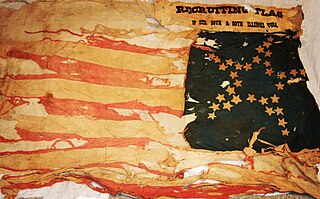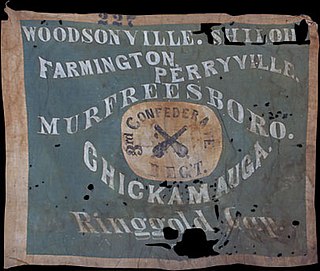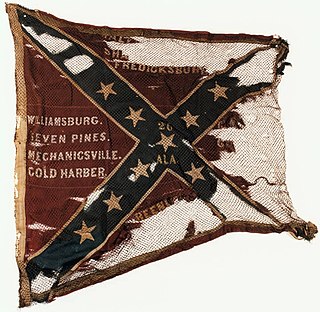Related Research Articles

The flags of the Confederate States of America have a history of three successive designs during the American Civil War. The flags were known as the "Stars and Bars", used from 1861 to 1863; the "Stainless Banner", used from 1863 to 1865; and the "Blood-Stained Banner", used in 1865 shortly before the Confederacy's dissolution. A rejected national flag design was also used as a battle flag by the Confederate Army and featured in the "Stainless Banner" and "Blood-Stained Banner" designs. Although this design was never a national flag, it is the most commonly recognized symbol of the Confederacy.
The Battle of Helena was fought on July 4, 1863, near Helena, Arkansas, during the American Civil War. Union troops captured the city in July 1862, and had been using it as a base of operations. Over 7,500 Confederate troops led by Lieutenant General Theophilus Holmes attempted to capture Helena in hopes of relieving some of the pressure on the Confederate army besieged in Vicksburg, Mississippi. Helena was defended by about 4,100 Union troops led by Major General Benjamin Prentiss, manning one fort and four batteries of artillery.
The Battle of Thompson's Station took place during the American Civil War on March 5, 1863, in Williamson County, Tennessee.
33rd Regiment may refer to:

The Battle of Baton Rouge was a ground and naval battle in the American Civil War fought in East Baton Rouge Parish, Louisiana, on August 5, 1862. The Union victory halted Confederate attempts to recapture the capital city of Louisiana.

The 80th Illinois Volunteer Infantry Regiment was an infantry regiment that served in the Union Army during the American Civil War. The regiment was composed of ten companies that drew primarily from eight southern Illinois counties. Over the course of the war the regiment traveled approximately 6,000 miles, and was in over 20 battles.

The 33rd Illinois Infantry Regiment was an infantry regiment from Illinois that served in the Union Army during the American Civil War. A number of the soldiers were college students and graduates, and for a time the regiment included a 17-piece band. The unit fought at Fredericktown in 1861, Cotton Plant in 1862, the Vicksburg campaign and Fort Esperanza in 1863, and at Spanish Fort in 1865. The original enlistees were mustered out in October 1864 while the veterans and recruits were mustered out in December 1865.

William Dunbar Holder was a prominent Confederate politician and soldier.

The following is an alphabetical list of articles related to the United States Commonwealth of Kentucky.

The 33rd Ohio Infantry Regiment was an infantry regiment in the Union Army during the American Civil War.
The 15th Arkansas Infantry Regiment or Josey's Arkansas Infantry Regiment was an infantry formation in the Confederate States Army during the American Civil War. The regiment was organized in May 1861 under the command of Colonel Patrick Cleburne. It served throughout the war in the western theater, seeing action in the Kentucky, Tennessee, and Georgia campaigns. Following its depletion in numbers the regiment was consolidated several times with other Arkansas regiments, finally merging in 1865 into the 1st Arkansas Consolidated Infantry Regiment. There were two other regiments which also received the designation of "15th Arkansas". The 21st (McRae's) Arkansas Infantry was redesignated 15th Arkansas in February 1863, but to avoid confusion, was normally referred to as the "Northwest regiment". This second "15th Arkansas" was surrendered at Vicksburg in July 1863. A third regiment, under command of Colonels Gee and later Johnson, also received the designation 15th Arkansas Infantry. This last regiment surrendered at Port Hudson, Louisiana, in July 1863.

The 18th Arkansas Infantry (Marmaduke's) (1861–1865) was a Confederate Army infantry regiment during the American Civil War. The unit was also briefly identified as the 1st Arkansas Infantry Battalion. The unit was most often referred to as the 3rd Confederate Infantry Regiment. The designation "Confederate Infantry Regiment" was intended to convey the difference between Provisional Confederate Army units and Regular Confederate Army Units, with Provisional units being those regiments who received a state designation such as "XX Arkansas Infantry Regiment". In practice, the designation was most often utilized when Regiments were assembled utilizing companies from more than one Confederate state. The "3rd Confederate Infantry Regiment" is occasionally misidentified as the 3rd Arkansas Infantry Regiment commanded by Colonel Van H. Manning.
The 1st Missouri Infantry was an infantry regiment that served in the Confederate States Army during the American Civil War. Originally commanded by Colonel John S. Bowen, the regiment fought at the Battle of Shiloh, where it was engaged near the Peach Orchard on April 6, 1862. On April 7, during the Union counterattacks at Shiloh, the regiment was instrumental in preventing the Washington Artillery from being captured. The regiment was next engaged at the Second Battle of Corinth, where it outflanked several Union positions. On the second day at Corinth, the regiment was only minimally engaged. On November 7, the 1st Missouri Infantry was combined with the 4th Missouri Infantry to form the 1st and 4th Missouri Infantry (Consolidated), as a result of heavy battle losses in both regiments.
The 2nd Arkansas Mounted Rifles (1861–1865) was a Confederate Army infantry regiment that served during the American Civil War. Raised in 1861, the regiment consisted of nine companies, which were drawn from various counties in Arkansas. Throughout the course of the war, the 2nd Arkansas Mounted Rifles fought in a number of battles, including those at Wilson's Creek and Pea Ridge, and participated in a number of campaigns such as Tullahoma, Atlanta and the Carolinas. The regiment's final battle came at Bentonville in March 1865 after which its remaining personnel were consolidated into the 1st Arkansas Consolidated Mounted Rifles.
The 33rd Alabama Infantry Regiment was an infantry unit from Alabama that served in the Confederate States Army during the U.S. Civil War. Recruited from the southeastern counties of Butler, Dale, Coffee, Covington, Russell and Montgomery, it saw extensive service with the Confederate Army of Tennessee before being nearly annihilated at the Battle of Franklin in 1864. Survivors from the regiment continued to serve until the final capitulation of General Joseph Johnston in North Carolina in 1865.
The Battle of Camp Wildcat was one of the early engagements of the American Civil War. It occurred October 21, 1861, in northern Laurel County, Kentucky during the campaign known as the Kentucky Confederate Offensive or Operations in Eastern Kentucky (1861). The battle is considered one of the first Union victories of the Civil War, and marked the second engagement of troops in the Commonwealth of Kentucky.

The 26th Alabama Infantry Regiment was an infantry regiment of the Confederate States Army regiment during the American Civil War. The regiment was composed of ten companies that came from various counties across Alabama. It is one of the few regiments that served both in the Army of Northern Virginia and Army of Tennessee.
The 2nd and 6th Missouri Infantry Regiment (Consolidated) was an infantry regiment that served in the Confederate States Army during the American Civil War. The regiment was formed on October 6, 1863, when the 2nd Missouri Infantry Regiment and the 6th Missouri Infantry Regiment were consolidated. The regiment first saw major action in the 1864 Atlanta campaign, fighting in the battles of Kennesaw Mountain and Peachtree Creek, the Siege of Atlanta, and several smaller actions. After the Confederates retreated from Atlanta, the regiment was part of a force that made an unsuccessful attack against a Union garrison during the Battle of Allatoona on October 5. The regiment then followed General John Bell Hood's Confederate Army of Tennessee into Tennessee, where it charged the Union works at the Battle of Franklin on November 30. At Franklin, the regiment suffered over 60 percent casualties, including the loss of many company commanders. After Franklin, the regiment was detached from the rest of the army to build fortifications, missing the Battle of Nashville. In March 1865, the regiment was transferred to Mobile, Alabama. On April 9, 1865, the regiment was captured at the Battle of Fort Blakeley; the survivors of the regiment were paroled at Jackson, Mississippi in May after the Army of Tennessee surrendered.

The 12th Louisiana Infantry Regiment was a unit of volunteers recruited in Louisiana that fought in the Confederate States Army during the American Civil War. Formed in August 1861, the regiment served in the Western Theater of the American Civil War and was unique in that there were 12 companies. The regiment garrisoned Island Number Ten before being stationed at Fort Pillow. It fought at Second Corinth in 1862 and Champion Hill and Jackson in 1863. A detachment served during the Siege of Vicksburg and was captured. In 1864, the regiment fought in the Meridian, Atlanta, and Franklin–Nashville campaigns, suffering heavy losses at Peachtree Creek and Franklin. It fought at Bentonville in 1865 before surrendering with General Joseph E. Johnston.
References
- ↑ "33rd Tennessee Infantry Regiment". Archived from the original on 11 December 2007. Retrieved 23 June 2011.